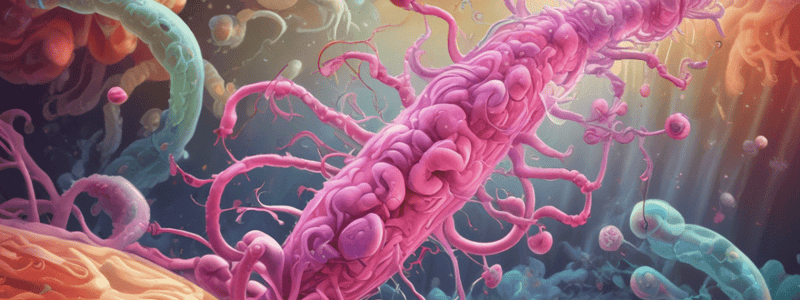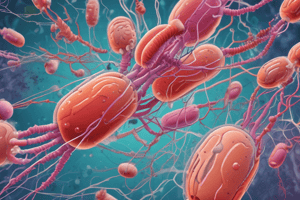Podcast
Questions and Answers
What is Acinetobacter baumannii primarily associated with?
What is Acinetobacter baumannii primarily associated with?
- Community-acquired infections
- Foodborne illnesses
- Nosocomial infections (correct)
- Vector-borne diseases
What makes Acinetobacter baumannii crucial in healthcare-associated infections?
What makes Acinetobacter baumannii crucial in healthcare-associated infections?
- Its slow growth rate
- Its ability to ferment glucose
- Its ability to survive in the environment for long periods and resistance to antimicrobial agents (correct)
- Its motility
What is the significance of Acinetobacter species in biotechnology?
What is the significance of Acinetobacter species in biotechnology?
- They are used as vectors for gene therapy
- They produce a carbohydrate-binding antibiotic, the Acinetobacter T7 bacteriophage (correct)
- They are used in cancer treatment
- They are used in vaccine development
Where are Acinetobacter baumannii strains commonly isolated from?
Where are Acinetobacter baumannii strains commonly isolated from?
What is the epidemiological significance of Acinetobacter baumannii?
What is the epidemiological significance of Acinetobacter baumannii?
What is the current status of Acinetobacter species taxonomy?
What is the current status of Acinetobacter species taxonomy?
What happened to some current Acinetobacter species since 2007?
What happened to some current Acinetobacter species since 2007?
Who is Acinetobacter baumannii named after?
Who is Acinetobacter baumannii named after?
What is the primary mechanism of β-lactam resistance in A. baumannii?
What is the primary mechanism of β-lactam resistance in A. baumannii?
What is the function of OXA-type β-lactamases in A. baumannii?
What is the function of OXA-type β-lactamases in A. baumannii?
What is the role of AdeB in A. baumannii?
What is the role of AdeB in A. baumannii?
What is the effect of the loss of OMPD on carbapenem resistance in A. baumannii?
What is the effect of the loss of OMPD on carbapenem resistance in A. baumannii?
What is the function of the quinolone resistance protein in A. baumannii?
What is the function of the quinolone resistance protein in A. baumannii?
What is the role of RecA expression in A. baumannii?
What is the role of RecA expression in A. baumannii?
What is the most common class of β-lactamase enzymes encountered in A. baumannii?
What is the most common class of β-lactamase enzymes encountered in A. baumannii?
What is the purpose of Pulsed field-gel electrophoresis (PFGE) with AciI in the study?
What is the purpose of Pulsed field-gel electrophoresis (PFGE) with AciI in the study?
What is the percentage of isolates that were resistant to meropenem in the study?
What is the percentage of isolates that were resistant to meropenem in the study?
What is the method used to identify the isolates in the study?
What is the method used to identify the isolates in the study?
What is the primary reason for the increased risk of A.baumannii infection in immunocompromised patients?
What is the primary reason for the increased risk of A.baumannii infection in immunocompromised patients?
What is the characteristic of Acinetobacter baumannii that allows it to form intracellular aggregates and trigger the formation of abscesses and mature biofilm structures on uroepithelial cell surfaces?
What is the characteristic of Acinetobacter baumannii that allows it to form intracellular aggregates and trigger the formation of abscesses and mature biofilm structures on uroepithelial cell surfaces?
What is the primary limitation of treatment options for multidrug-resistant A.baumannii infections?
What is the primary limitation of treatment options for multidrug-resistant A.baumannii infections?
What is the primary mechanism of carbapenem resistance in A.baumannii?
What is the primary mechanism of carbapenem resistance in A.baumannii?
What is the significance of the antimicrobial susceptibility pattern of clinical A.baumannii strains?
What is the significance of the antimicrobial susceptibility pattern of clinical A.baumannii strains?
Why are patients infected with CRAB strains often bedridden?
Why are patients infected with CRAB strains often bedridden?
What is the primary consequence of the misuse of antibiotics in the development of antimicrobial resistance?
What is the primary consequence of the misuse of antibiotics in the development of antimicrobial resistance?
What is the usual treatment approach for carbapenem-resistant A.baumannii infections?
What is the usual treatment approach for carbapenem-resistant A.baumannii infections?
What is the significance of rapid molecular diagnostic tests for the cfres gene?
What is the significance of rapid molecular diagnostic tests for the cfres gene?
What is the characteristic of A.baumannii that makes it an important virulent factor in urinary tract infections?
What is the characteristic of A.baumannii that makes it an important virulent factor in urinary tract infections?
What is the significance of the study on the antimicrobial susceptibility pattern of clinical A.baumannii strains?
What is the significance of the study on the antimicrobial susceptibility pattern of clinical A.baumannii strains?
What is the current status of therapeutic agents for carbapenem-resistant A.baumannii?
What is the current status of therapeutic agents for carbapenem-resistant A.baumannii?
What is the primary reason for the increased severity of antibiotic resistance in A.baumannii infections?
What is the primary reason for the increased severity of antibiotic resistance in A.baumannii infections?
What is the significance of efflux pumps in carbapenem resistance?
What is the significance of efflux pumps in carbapenem resistance?
What is the characteristic of A.baumannii that makes it an opportunistic pathogen?
What is the characteristic of A.baumannii that makes it an opportunistic pathogen?
What is the expected outcome of using combination therapy for carbapenem-resistant A.baumannii infections?
What is the expected outcome of using combination therapy for carbapenem-resistant A.baumannii infections?
What is the primary concern regarding the emergence of carbapenem-resistant A.baumannii?
What is the primary concern regarding the emergence of carbapenem-resistant A.baumannii?
What is the significance of the comparison of the resistance pattern of A.baumannii from various clinical samples?
What is the significance of the comparison of the resistance pattern of A.baumannii from various clinical samples?
What is the significance of colistin in the treatment of carbapenem-resistant A.baumannii?
What is the significance of colistin in the treatment of carbapenem-resistant A.baumannii?
What is the result of carbapenem-hydrolysing enzymes in A. baumannii?
What is the result of carbapenem-hydrolysing enzymes in A. baumannii?
What regulates the open state of membrane porins in A. baumannii under normal conditions?
What regulates the open state of membrane porins in A. baumannii under normal conditions?
What is the main reason for the development of carbapenem resistance in A. baumannii?
What is the main reason for the development of carbapenem resistance in A. baumannii?
What is the role of efflux pumps in A. baumannii?
What is the role of efflux pumps in A. baumannii?
Which typing method is used to investigate global diversity, population structure, and evolutionary development of A. baumannii?
Which typing method is used to investigate global diversity, population structure, and evolutionary development of A. baumannii?
Why is A. baumannii difficult to control in healthcare settings?
Why is A. baumannii difficult to control in healthcare settings?
What is the significance of CR-AB in healthcare settings?
What is the significance of CR-AB in healthcare settings?
What is the main challenge in managing CR-AB?
What is the main challenge in managing CR-AB?
What is the primary niche of A. baumannii?
What is the primary niche of A. baumannii?
What is a major challenge in treating CRAB infections?
What is a major challenge in treating CRAB infections?
What is the primary reason for the limited therapeutic use of tigecycline, polymyxins, and minocycline?
What is the primary reason for the limited therapeutic use of tigecycline, polymyxins, and minocycline?
What is a key factor in the development of novel therapeutic strategies for CRAB infections?
What is a key factor in the development of novel therapeutic strategies for CRAB infections?
What is a limitation of using aminoglycosides to treat CRAB infections?
What is a limitation of using aminoglycosides to treat CRAB infections?
What is a innovative approach to treating heavily infected ventilatory system biofilms?
What is a innovative approach to treating heavily infected ventilatory system biofilms?
What is a challenge in evaluating the efficacy of antibiotics against CRAB?
What is a challenge in evaluating the efficacy of antibiotics against CRAB?
What is a major factor contributing to the high-level resistance of Acinetobacter baumannii?
What is a major factor contributing to the high-level resistance of Acinetobacter baumannii?
What is the significance of studying the molecular mechanisms of carbapenem resistance?
What is the significance of studying the molecular mechanisms of carbapenem resistance?
According to the content, what is the classification of CR-AB by some reviewers?
According to the content, what is the classification of CR-AB by some reviewers?
What is a key factor in the development of novel therapeutic strategies for CRAB infections?
What is a key factor in the development of novel therapeutic strategies for CRAB infections?
What is a limitation of using polymyxins to treat CRAB infections?
What is a limitation of using polymyxins to treat CRAB infections?
What is the primary mechanism by which CR-AB possesses high resistance to antibiotics?
What is the primary mechanism by which CR-AB possesses high resistance to antibiotics?
What is the effect of CP-AB bacteremia on the length of hospital stay and hospitalization costs?
What is the effect of CP-AB bacteremia on the length of hospital stay and hospitalization costs?
What is a key factor in the effective management of CRAB infections?
What is a key factor in the effective management of CRAB infections?
What is the association between CP-AB infection and mortality among patients?
What is the association between CP-AB infection and mortality among patients?
What is the primary factor contributing to the high mortality rates of CRAB infections in hospitals?
What is the primary factor contributing to the high mortality rates of CRAB infections in hospitals?
What is the benefit of early treatment with appropriate antimicrobials in surgical ICUs and trauma patients?
What is the benefit of early treatment with appropriate antimicrobials in surgical ICUs and trauma patients?
What is the main reason for the emergence of chlorhexidine-resistant strains of A. baumannii?
What is the main reason for the emergence of chlorhexidine-resistant strains of A. baumannii?
What is the primary goal of monitoring CR-AB outbreaks?
What is the primary goal of monitoring CR-AB outbreaks?
What is the consequence of limited therapeutic options for Acinetobacter infection?
What is the consequence of limited therapeutic options for Acinetobacter infection?
What is the primary purpose of establishing a working relationship between academia, the pharmaceutical industry, policy leaders, and health authorities?
What is the primary purpose of establishing a working relationship between academia, the pharmaceutical industry, policy leaders, and health authorities?
What is the consequence of the excessive use of antibiotic agents in everyday practice?
What is the consequence of the excessive use of antibiotic agents in everyday practice?
What is the risk factor for subsequent infection in patients colonized with CP-AB before ICU admission?
What is the risk factor for subsequent infection in patients colonized with CP-AB before ICU admission?
What is the significance of the study's findings on the prevalence of CR-AB in major medical centers and affiliated hospitals?
What is the significance of the study's findings on the prevalence of CR-AB in major medical centers and affiliated hospitals?
What is the primary concern for practitioners and researchers regarding bacterial resistance?
What is the primary concern for practitioners and researchers regarding bacterial resistance?
What is the significance of the increased use of carbapenem antibiotics in Europe?
What is the significance of the increased use of carbapenem antibiotics in Europe?
What is the primary reason for the lack of effective antibiotics against A. baumannii?
What is the primary reason for the lack of effective antibiotics against A. baumannii?
What is the primary mechanism of the spread of CRAB infections in hospitals?
What is the primary mechanism of the spread of CRAB infections in hospitals?
What is the significance of the resistance to carbapenems and colistin in A. baumannii?
What is the significance of the resistance to carbapenems and colistin in A. baumannii?
What is the primary purpose of summarizing the antibiotic resistance of A. baumannii?
What is the primary purpose of summarizing the antibiotic resistance of A. baumannii?
Flashcards are hidden until you start studying
Study Notes
Introduction to Carbapenem-Resistant Acinetobacter Baumannii (CRAB)
- Acinetobacter baumannii is a gram-negative, strictly aerobic, non-fermentative, and non-motile coccobacillus that is commonly associated with nosocomial infections.
- It is a significant concern in biotechnology due to its carbohydrate-binding antibiotic properties and its role in bioremediation.
- CRAB is a major pathogen in nosocomial infections, particularly in immunocompromised patients.
Taxonomy and Classification
- Acinetobacter baumannii is one of the valid species from the WHO label I.
- Outbreaks are mainly secondary to infections in hospital settings, making it crucial for antimicrobial multicenter security.
- There are two major clonal lineages of CRAB: Europe and Europe ClaI.
Pathogenicity and Clinical Relevance
- CRAB can cause a broad range of infections across different infection focus and severity levels, especially in critical patients.
- It is a major threat to hospital infections, particularly in ICU patients, patients with surgical wounds, and those with cancer syndrome.
- CRAB is associated with high mortality rates, especially in patients with hemodialysis.
Mechanisms of Resistance
- β-lactamases and penicillin-binding proteins (PBP) play an important role in the β-lactam resistance of CRAB.
- The efflux pumps in CRAB, including AdeABC, AdeFGH, and AdeIJK, contribute to the carbapenem-resistant phenotype.
- The loss of outer membrane porins (OMP) and the over-expression of efflux pumps also contribute to carbapenem resistance.
Epidemiology and Global Spread
- The global spread of CRAB has been described using different typing methods, including antibiotic resistance patterns, DNA macro-restriction analysis, and multilocus sequence typing (MLST).
- CRAB is commonly found in hospital facilities in Europe and the United States, but its prevalence is higher in emerging countries.
- The distribution of CRAB in healthcare settings is not uniform, and its exact ecological niche is still unknown.
Impact on Clinical Outcomes
- CRAB is highly destructive and toxic to the healthcare system, and its treatment and management strategies need to be transformed.
- The working knowledge of CRAB's mechanics, its genetic plasticity, and molecular resistance controls are essential to define the efficient path for overcoming CRAB.
- Clinical reports on CRAB sequences are currently insufficient, and monitoring CRAB outbreaks is crucial to prevent further spread.
Treatment Strategies for Carbapenem-Resistant Acinetobacter Baumannii
- Antimicrobial combination therapy has been suggested as an alternative method to optimize the management of multidrug-resistant CRAB infections.
- The development of new agents that can replace the current therapeutic options is years away, and effective therapeutic monitoring is critical.
- Novel therapeutic strategies, including antimicrobial agents and non-antibiotics, are being investigated to combat CRAB.
Antibiotic Options
-
Various antibiotics, including polymyxins, tigecycline, and minocycline, have been used to treat CRAB infections, but their efficacy can be affected by the strain's resistance mechanism and virulence factors.
-
Significant variability is observed in the response of different strains to antibiotic treatment.### Carbapenem-Resistant Acinetobacter baumannii (CRAB)
-
CRAB is associated with high rates of morbidity and mortality, and its spread has been rapid, reaching all continents since its first identification in 2001.
-
Strains acquire carbapenem resistance mainly through the production of carbapenem hydrolyzing class D β-lactamases (CHDL) and the expression of efflux pumps that remove the drugs from the cells.
Challenges in Treating CRAB Infections
- Other less effective antibiotics have proven to cause problems for infections caused by strains, and polymyxins show low efficacy in treating ventilator-associated pneumonia.
- Aminoglycosides are effective in clinical therapy, but their intracellular concentrations are low, and no β-lactam drugs are available to enhance their intracellular concentration.
Antibiotic Efficacy
- 19 different antibiotics from 10 families were evaluated against CRAB, and their inhibitory capacity was assessed using the disk-diffusion test.
- The inhibition zones only serve to quantify antibiotic efficacy overall, since infection sites generate extreme variable cell growth environments.
Combination Therapy
- Animal studies have shown that combination therapy, such as tigecycline and intravenous colistin, or imipenem plus colistin, is more effective than monotherapy.
- The combination of Acinetobacter baumannii phage MS-evolution and polymyxin B has also been shown to be more effective in eradicating infected Galleria mellonella larvae.
Alternative Therapies
- Colistin, tigecycline, and aminoglycosides are currently being used for the treatment of carbapenem-resistant A.baumannii in the clinic.
- The development of rapid molecular diagnostic tests for the cfres gene or the bioassay would be of great help in both the rapid and proper therapeutic treatment of A.baumannii infections.
Prevention and Infection Control Measures
- Outbreaks of CRAB continue to increase and cause high mortality rates in hospitals, especially in intensive care units.
- Strict adherence to protection measures, such as hand hygiene and environmental cleaning, is essential in preventing the spread of CRAB.
Future Directions in Research and Development
- Despite significant advances in understanding the carbapenem resistance mechanism of A.baumannii, progress in the development of new drugs lags behind that of resistance.
- A collaborative effort between academia, the pharmaceutical industry, policy leaders, and health authorities is necessary to advance established methods and develop new antimicrobial agents.
Studying That Suits You
Use AI to generate personalized quizzes and flashcards to suit your learning preferences.




